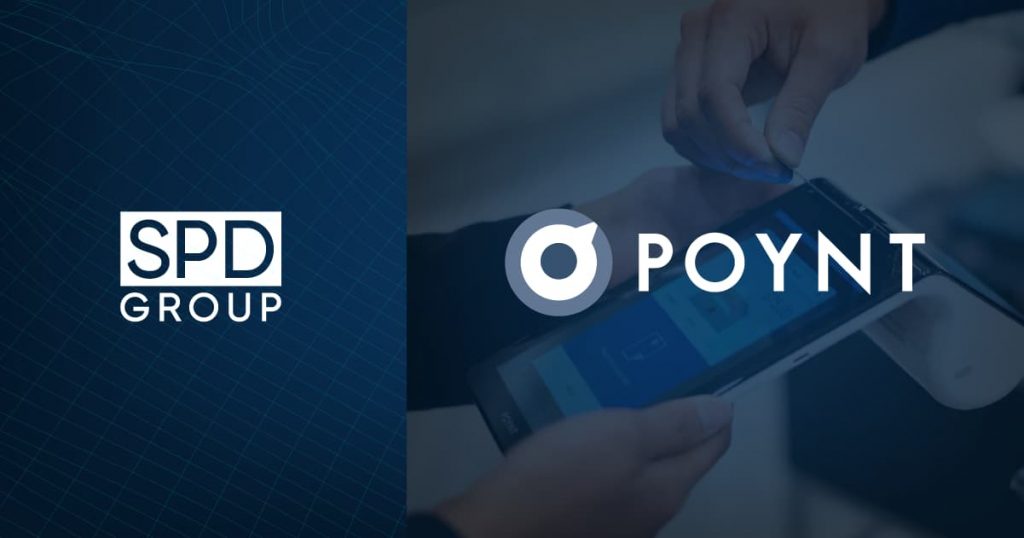Point of Sale (POS) systems, a combination of hardware and software, designed to streamline the process of sales transactions for businesses, are more popular than ever.
The market for these systems is growing exponentially. In 2023, it was valued at USD 103.83 billion, and in 2030 it is forecasted to reach USD 181.5 billion, with a CAGR of 8.3%, according to Grand View Research. Mobile POS payments transaction value alone is USD 0.79 trillion, and in four years it is estimated to reach USD 1.45 trillion, if Statista is to be believed.
Currently, Square is holding a leading position as the top POS provider with a 29.80% market share, as reported by 6sense. Other notable competitors include Toast and Clover, with 25.24% and 7.06% market shares respectively. However, with expected market growth, there definitely will be new opportunities for cutting-edge POS solutions. That’s why in this article, we decided to discuss how to develop POS system software step-by-step and provide you with the most valuable information on this topic.
Decide on the POS System Type
Although traditional Point of Sale (POS) systems cater to brick-and-mortar retail stores, the necessity for a traditional POS system is not as pronounced for online-only stores. Nevertheless, online-only stores can derive advantages from systems and tools that fulfill the same functions, promoting seamless operations and enhancing the overall customer experience. It’s crucial to recognize that all POS systems have software at their core, so exceptional POS software development services are required for each of them.
Let’s review the most common types of these systems.
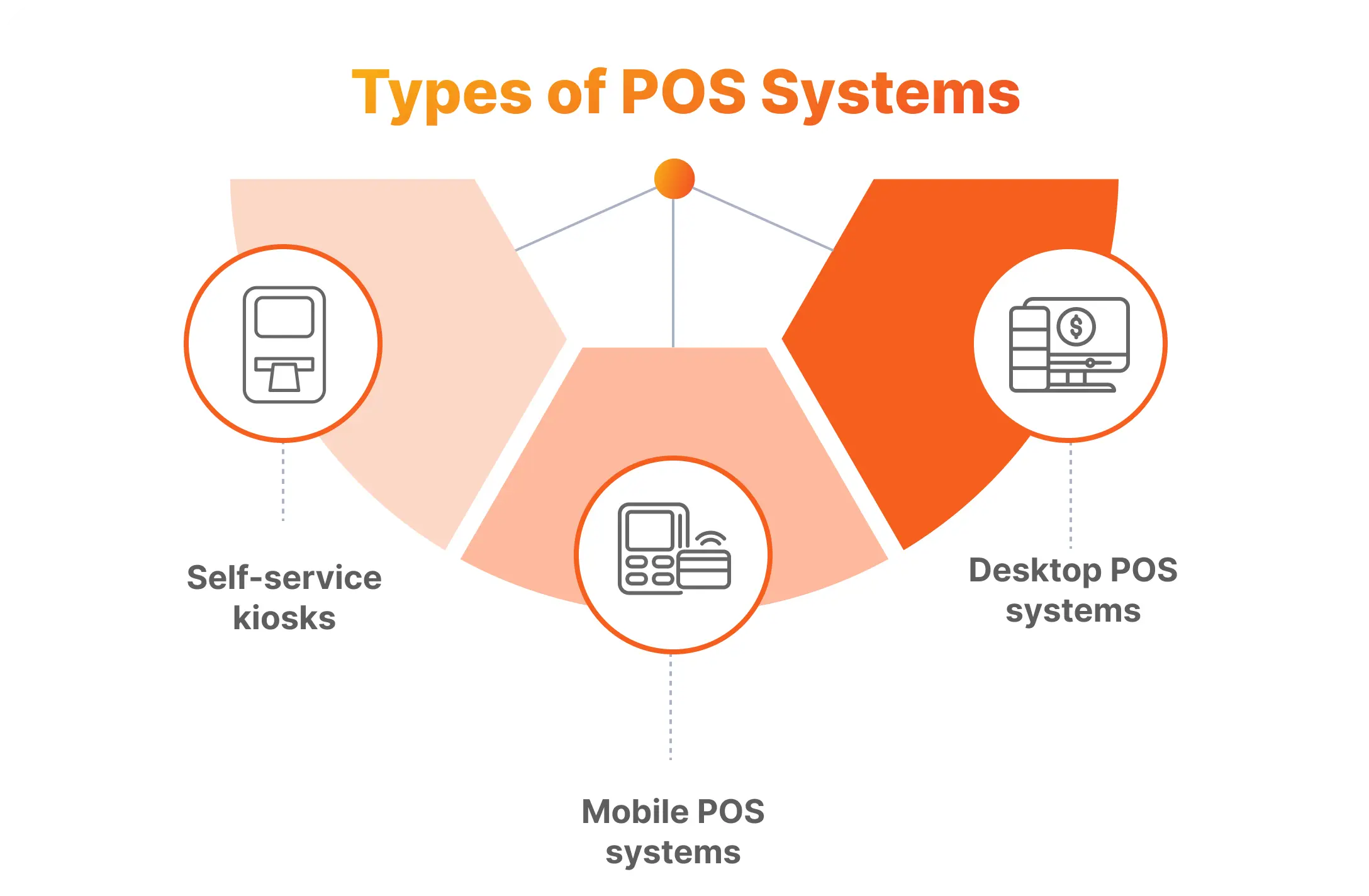
Self-Service Kiosks
They are typically used for places like grocery stores, gas stations, and restaurants to enable customers to place and customize their orders without interacting with a cashier. This type requires POS devices with specific hardware components, such as touchscreens, card readers, receipt printers, and sometimes even barcode scanners, depending on the nature of the business.
These kiosks POS solutions improve customer experience dramatically by:
- Enhancing operational efficiency.
- Reducing wait times.
- Empowering customers to control their transactions.
Desktop POS Systems
These are software applications installed on computers, typically with a dedicated terminal or workstation. They may include peripherals like cash registers, receipt printers, and barcode scanners. Desktop POS systems are versatile and can be employed by various businesses with a fixed checkout location.
Desktop systems can offer additional features for the business, including:
- Inventory management
- Sales reporting
- Employee tracking.
Mobile POS Systems
These systems operate on handheld devices such as tablets or smartphones. They often include card readers that can connect to mobile devices, making mobile POS systems portable and flexible.
Mobility, as the name implies, is the key advantage of these systems. They allow businesses to take payments anywhere, making them especially useful for on-the-go or temporary setups, food trucks, pop-up shops, market stalls, and even traditional retail businesses looking to offer a more personalized shopping experience. Additionally, they often integrate with other business applications for seamless operations.
Decide on Data Storage
Deciding between On-Premise and Cloud-Based data storage for a custom Point of Sale (POS) system involves considering various factors related to your business requirements, budget, scalability, and technical preferences. We will provide some clarity into Point of Sale software development by comparing the two in the following sections, considering key business concerns.
Cost Considerations
- On-Premise: Upfront costs can be significant, including server hardware, networking equipment, and the costs associated with setting up and maintaining a physical server room.
- Cloud-Based: The initial investment is typically lower, however, there will be ongoing subscription costs. Cloud-based solutions often involve a pay-as-you-go model, allowing you to scale your storage needs as your business grows.
Scalability
- On-Premise: Scaling on-premise infrastructure can be more complex and time-consuming. When your business will experience growth, you may need to invest in additional hardware and infrastructure upgrades.
- Cloud-Based: You can easily adjust your storage capacity based on your business needs, either scaling up or down, without the need for significant hardware investments.
Maintenance and Management
- On-Premise: With on-premise solutions, your POS system software development team will be responsible for hardware maintenance, updates, and security. This requires ongoing monitoring and can be resource-intensive.
- Cloud-Based: Cloud providers handle the maintenance, updates, and security of the infrastructure. This allows your IT team to focus on other critical aspects of your POS terminal software development process.
Accessibility and Remote Management
- On-Premise: On-premise systems may pose challenges for remote access and management and may require additional configurations for secure remote access.
- Cloud-Based: Cloud solutions offer convenient remote access, allowing authorized users to manage the system from anywhere with an internet connection. This is especially beneficial for businesses with multiple operational locations or those adopting a mobile POS approach.
Security and Compliance
- On-Premise: You have direct control and responsibility over the security measures implemented in your on-premise environment. This can be advantageous, as ensuring the highest level of security is one of the main Fintech development challenges.
- Cloud-Based: Cloud providers invest heavily in implementing the latest security measures, but you must ensure that the chosen provider complies with relevant industry regulations and standards. Especially, if your industry has specific regulatory requirements, as ensuring data security in Fintech is always of the utmost importance.
Keep in mind five main payment processing compliance regulations your fintech company should meet!
Backup and Disaster Recovery
- On-Premise: The responsibility for implementing robust backup and disaster recovery mechanisms is on you, which may involve additional costs and increased complexity on your side.
- Cloud-Based: Cloud providers typically offer some kind of automated backup and recovery mechanisms as part of their services, enhancing data resilience and minimizing downtime in case of unforeseen events.
It will be a good idea to conduct a thorough analysis and consult an experienced POS software development company to determine the most suitable solution for your custom system.
Decide on the Necessary Integrations
Integrating various modules with your system enhances overall business efficiency and provides a seamless experience for both customers and staff. Modern POS systems development for eCommerce, or any other industry, allows these integrations to happen and benefit your organization.
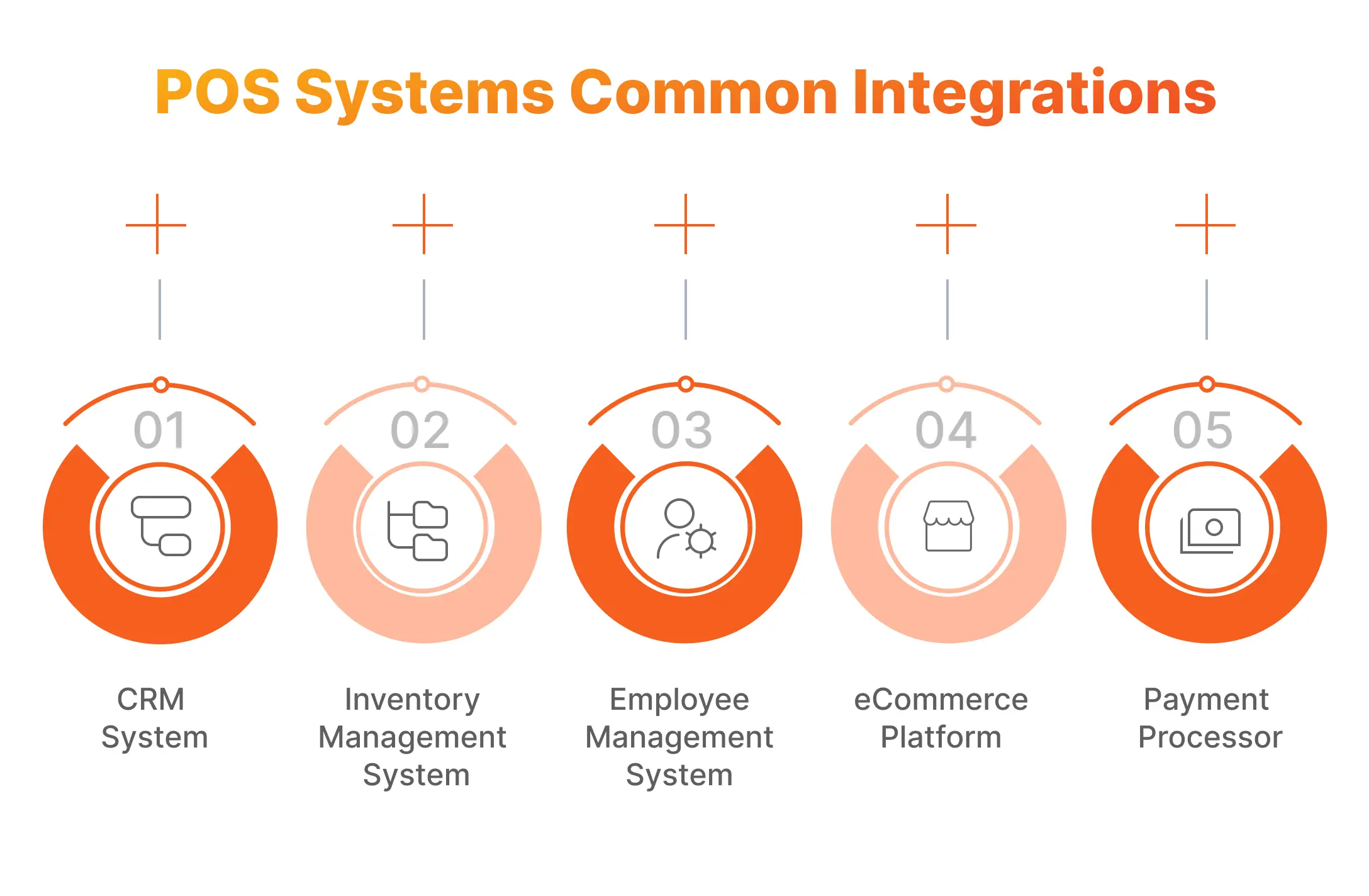
CRM Integration
Integrating Customer Relationship Management (CRM) software with your system allows managing customer information, preferences, and interactions, introducing features like:
- Personalized Customer Experience: Accessing customer profiles, customer purchase history, and preferences during transactions for personalized service.
- Targeted Marketing: Leveraging customer data to create targeted marketing campaigns and promotions.
- Loyalty Programs: Integrating loyalty programs within the POS system to reward and retain customers.
Inventory Management System
Integration with an Inventory Management System ensures accurate tracking of product levels, prevents stock out, and streamlines replenishment processes. Custom software development services allow the implementation of the following features after the successful integration:
- Real-Time Inventory Updates: Keeping inventory levels up-to-date across all channels, preventing overselling and stock discrepancies.
- Automated Reordering: Setting up automatic reorder triggers based on predefined inventory thresholds.
- Centralized control: Managing all aspects of inventory, including stock adjustments and transfers, from a centralized system.
Employee Management System
Integrating with an Employee Management System streamlines workforce-related processes, such as scheduling, time tracking, and performance management. This integration will allow minimizing understaffing or overstaffing situations, as well as ensuring accurate payroll calculations.
eCommerce Platform
Integrating your POS system with an eCommerce platform synchronizes in-store and online sales, providing an omnicommerce experience for customers and ensuring centralized order management.
At SPD Technology, we have hands-on omnicommerce payment solution development expertise, working on AccountingSync, E-commerce, Virtual Terminal, Physical Terminal Software, Invoices, Card-on-File, Recurring Payments, Loyalty, Messaging, and Advanced Cash Register development for Poynt, one of the globally leading open commerce platform providers. This rich expereince enabled us to provide businesses from different niches with an insightful consultation and the required Fintech software development services to maximize the benefits of eCommerce platform and POS system integration.
Payment Processors
Integrating with payment processors ensures secure and efficient payment transactions and expands options for various payment methods. When done wisely, this integration reduces transaction times and enhances the overall checkout experience.
What’s more, becoming a payment processor for other companies can be another business idea worth considering. Find a payment processing company business plan template in our dedicated guide!
Shortlist the Necessary Features
Custom POS software for the Retail industry, for example, can be as complex and sophisticated as your business scenario requires. However, some functionalities and features are necessary for almost any POS solution, and in the next sections, we will review the most important ones.
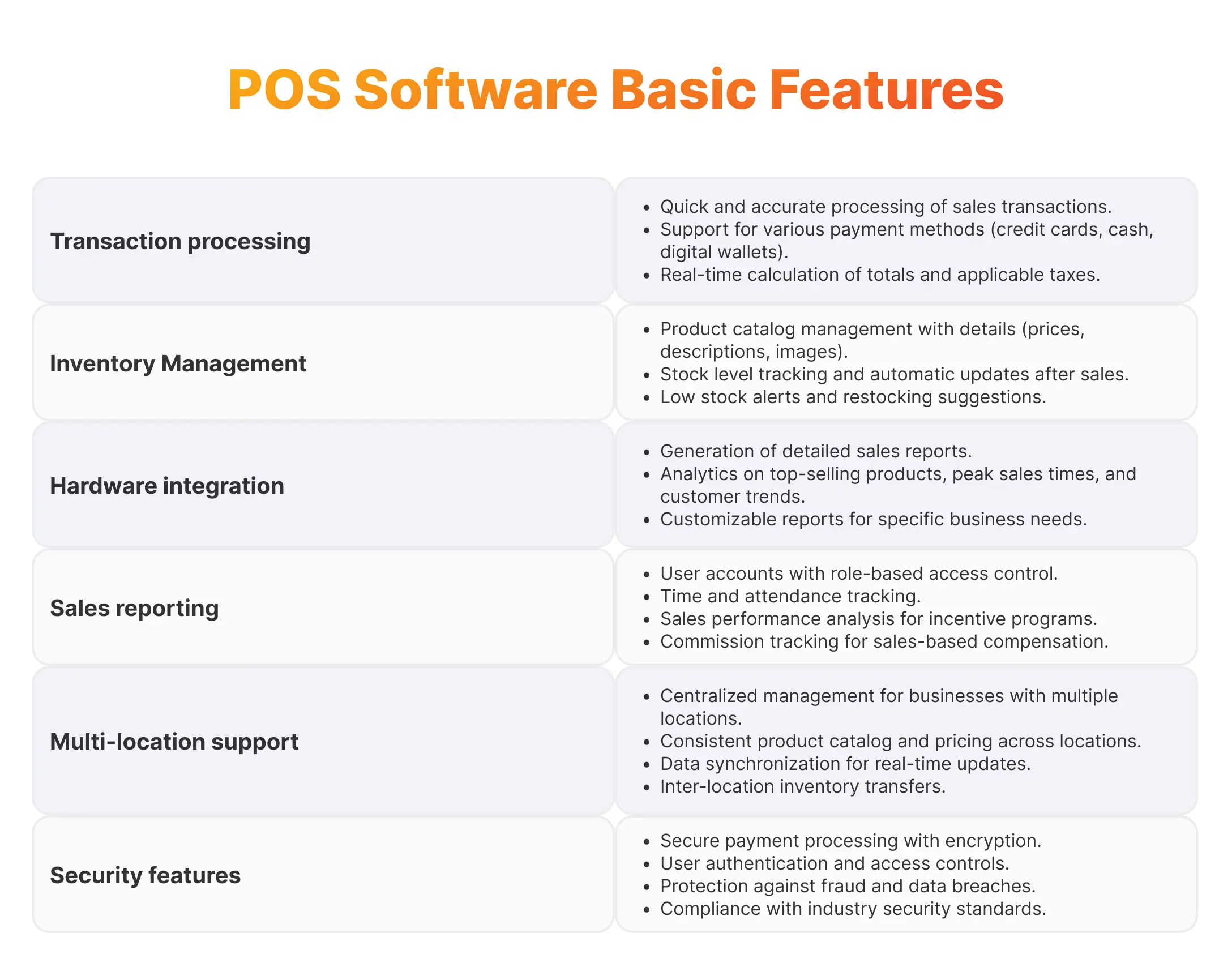
Transaction Processing
Your system must ensure swift and precise handling of sales transactions, accommodating various popular payment methods, including credit cards, cash, and digital wallets. It will be convenient if the system performs real-time calculations for totals and applicable taxes during transactions.
Find out how to build a payment processing app and discover the actionable tips shared by the SPD Technology Delivery Director!
Inventory Management
The system should be on top of the product catalogs with detailed information on prices, and having correct descriptions and images. Constant monitoring of stock levels with automatic updates following sales transactions is mandatory, and it will be nice to have alerts when stock levels are low with restocking suggestions.
Hardware Integration
In some cases, compatibility with POS hardware like barcode scanners, receipt printers, and cash drawers, as well as integration with scales for weighted items may be required.
Sales Reporting
A very useful feature is implementing customizable and comprehensive sales reports, offering insights into various aspects of sales activities. Having accurate POS data will help to analyze top-selling products, identification of peak sales times, and track customer trends.
Employee Management
Various aspects of employee management can also be improved, as it is possible to implement user accounts with role-based access control to manage system security, as well as monitor employee working time and attendance. Additionally, you can implement analysis of sales performance for incentive programs and commission tracking for sales-based compensation.
Multi-location Support
You can implement functionality that will allow centralized management capabilities if your business operates in multiple locations. This will help you to ensure uniformity in product catalogs and pricing across different locations and achieve real-time synchronization of data for updates across multiple locations, including inter-location inventory transfers.
Security Features
Just like with implementing KYC standards in Fintech in general that we discussed in one of our previous articles, Point of Sale system development requires vital security measures, including:
- The implementation of secure payment processing with encryption
- Ensuring only authorized user accounts have access with robust authentication and access controls.
- Incorporation of measures to protect against fraud and data breaches.
- Adherence to the latest industry security standards to maintain the integrity and confidentiality of data.
In our guide on how to make a POS system, it is impossible to skip the technical aspects of this process, including designing User Interface/User Experience elements, developing Back-End components, and conducting rigorous testing. The execution of these aspects largely impacts how much does it cost to build a POS system in your particular case, so let’s discuss it.
Think Over UI/UX Design Elements
When designing a POS system, you have to think about two categories of UI/UX design elements. These are customer-facing elements and the elements of the admin panel for staff. Let’s take a closer look at each of them.
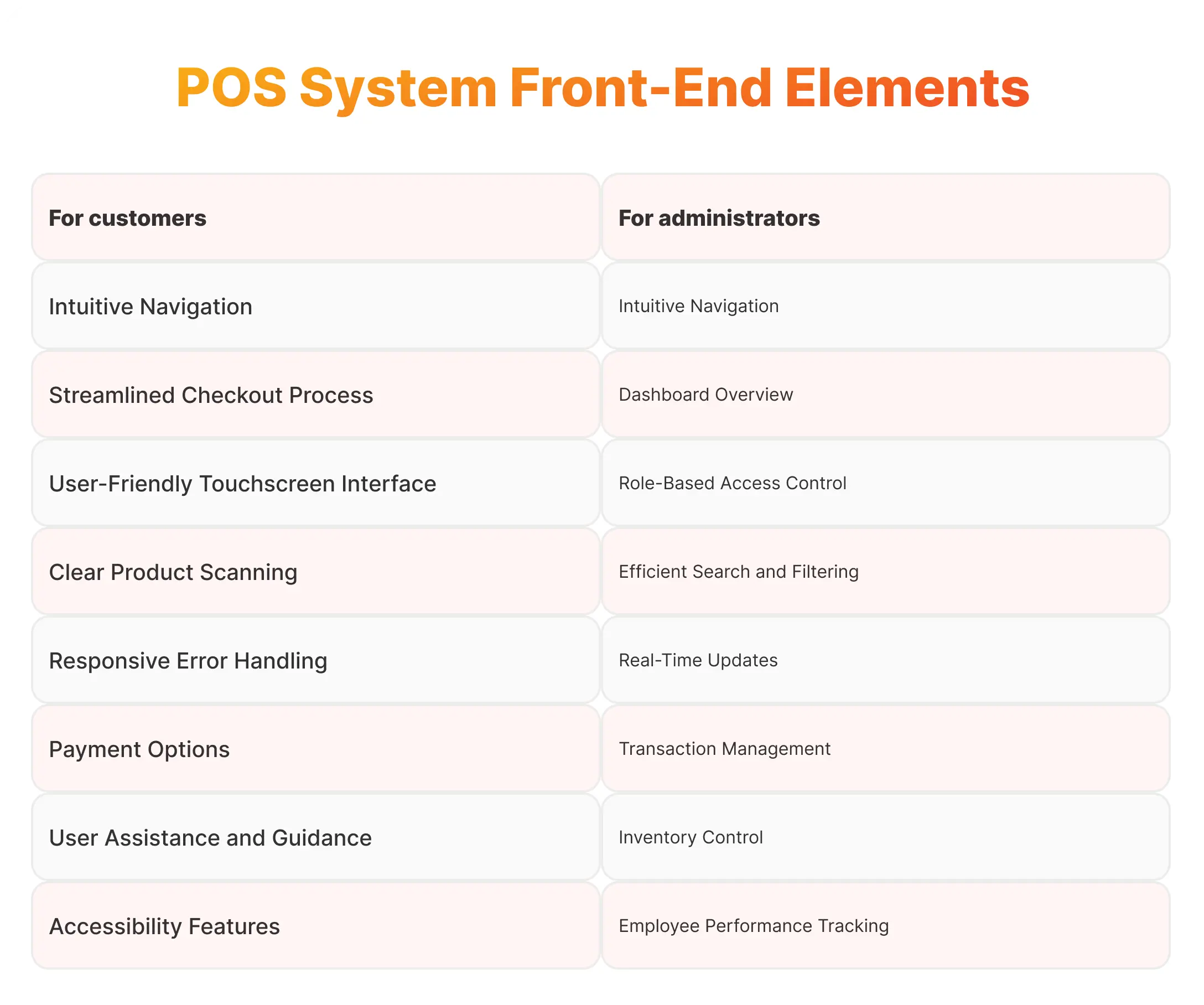
Customer-Facing Elements
- Intuitive Navigation. To provide this, your designer must organize the display layout logically and intuitively. Leverage universally recognized icons for clearly labeling each section and enhancing user understanding.
- Streamlined Checkout Process. Minimize steps required for checkout, ensuring a seamless flow from scanning items to completing the payment. Visual indicators or progress bars will help to seamlessly guide users through each stage of the checkout process.
- User-Friendly Touchscreen Interface. Speaking of touchscreens, it is important to optimize the touchscreen interface for responsiveness, ensuring that users can interact smoothly with the system. Don’t forget to Implement large, touch-friendly buttons and controls for a user-friendly experience.
- Clear Product Scanning. When required, design an efficient interface for product scanning with a responsive barcode scanner. It is important to provide visual and auditory feedback upon successful scans to confirm item additions to the transaction.
- Responsive Error Handling. Implement clear and concise error messages with simple instructions for issue resolution. For this goal, leverage visual cues, such as color changes or icons, to indicate errors and guide users on corrective actions.
- User Assistance and Guidance. Include on-screen assistance for users unfamiliar with the self-service system, while also displaying a prominent help button or icon linking to FAQs or assistance information for additional support.
- Accessibility Features. Ensure clear contrast and legible fonts for users with visual impairments. Make the interface compatible with screen readers for users with visual or cognitive disabilities.
- Language and Localization. Support multiple languages to be ready to offer services to a diverse customer base. Consider the localization of currency symbols, date formats, and other regional preferences, where applicable.
- Payment Options. Make sure to display available payment options clearly, providing prompts for each step, ensuring a smooth payment experience.
Admin Panel for Staff
- Dashboard Overview. It is crucial to display essential metrics such as total sales, average transaction value, and top-selling products with additional performance indicators like transaction success rates and customer satisfaction scores. Utilize visually appealing charts and graphs to represent data trends, implementing interactive elements, and allowing staff to hover over data points for more detailed information.
- Role-Based Access Control. Define specific user roles based on staff responsibilities, and assign specific permissions to each role to restrict access to sensitive features and data. Clearly define and label each user role to facilitate easy identification, providing a detailed explanation of the responsibilities and access associated with each role.
- Intuitive Navigation. Design a menu structure that clearly reflects the workflow of your custom POS system, while grouping related features under intuitive categories to streamline navigation. Group menu items logically based on their functions to reduce cognitive load by prioritizing commonly used features, and placing them prominently in the navigation structure.
- Efficient Search and Filtering. Implement a robust search functionality allowing admins to search by transaction ID, product name, or customer details and include auto-suggestions and advanced search for quick and accurate results. Enable admins to save and reuse frequently used search parameters.
- Real-Time Updates. Display real-time updates on sales, inventory levels, and other critical data, while also implementing automatic refresh at regular intervals or push notifications for immediate information. Allow admins to set customizable alerts for specific events, such as low stock levels or high transaction values. It will be convenient to provide options for notification preferences like email, in-app alerts, SMS, etc.
- Transaction Management. Include a dedicated section for managing and monitoring transactions, displaying order details, payment status, and options for processing refunds. Provide easy access to transaction histories with search and filtering options, allowing admins to view and reprint receipts for customer service or auditing purposes.
- Inventory Control. Design an inventory management section for adding, removing, and adjusting products, including bulk update options for efficient management of product catalogs.
- Employee Performance Tracking. Track sales metrics for individual employees, such as total sales, average transaction value, and item count, recognizing and displaying individual achievements, such as reaching sales targets. Provide visualizations, such as charts or graphs, for easy performance comparisons among employees.
Proceed with POS System Back-End Development
Creating the back-end part of the POS system is the most complex and time-consuming part of the project. Below are the main attention points you have to keep in mind when creating POS software back-end.
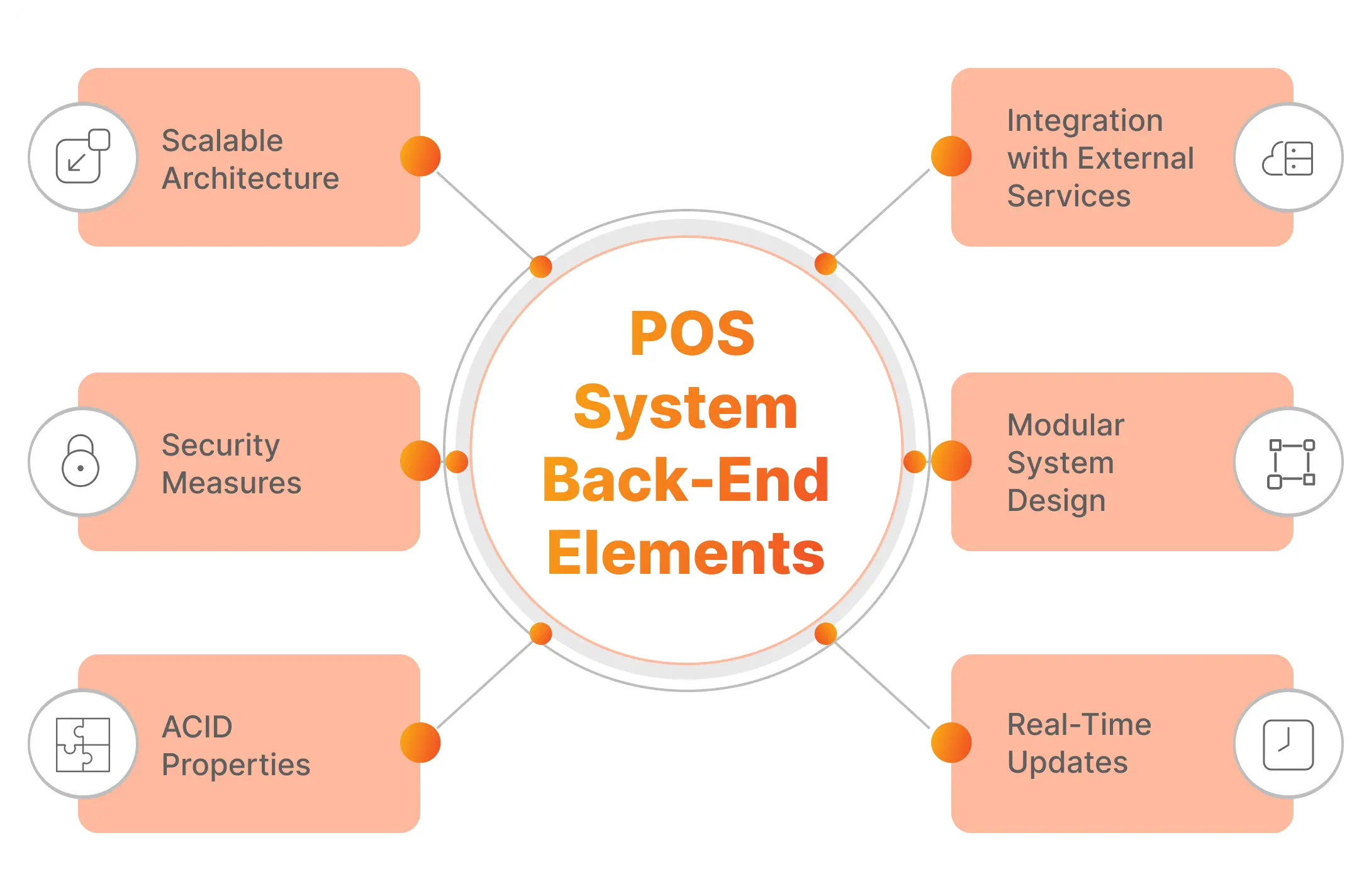
Scalable Architecture
Choose a scalable database system (e.g., SQL or NoSQL) based on the specific requirements of the POS system and optimize database schema and indexing for efficient data retrieval.
Adopt a microservices architecture to break down the system into independent, modular components with each microservice handling specific functionalities, facilitating scalability and ease of maintenance.
Security Measures
Implement end-to-end encryption for data transmission, securing communication between different components of the system. Enforce strict access controls and authentication mechanisms for both users and external services.
ACID Properties
Ensure Atomicity, Consistency, Isolation, and Durability (ACID) properties for transaction processing, while employing database transactions to maintain data integrity during complex operations.
Integration with External Services
Implement secure and standardized APIs for seamless integration with payment processors, adhering to the latest industry standards. It will be a plus to develop APIs to integrate with popular accounting software and inventory management systems as well, allowing for bidirectional data synchronization to ensure consistency across multiple platforms.
Modular System Design
Design a modular system with well-defined APIs for each component, that allows for easy integration of new components and services as your business grows and the system evolves.
Real-Time Updates
Utilize WebSockets or server-sent events for real-time communication between the Back-End and the Front-End. This will allow pushing updates to the Front-End immediately, especially for critical information such as inventory and sales data.
Continue with POS System Testing
Like any other software product, a POS system should be carefully tested by using several different approaches.
- Functional Testing: ensures that each function of the POS system operates as expected. It involves testing individual functions, features, and components to verify that they meet the specified requirements.
- Integration Testing: focuses on ensuring that different components of the POS system work together seamlessly. It involves testing the interactions and data exchange between integrated modules, external services, and hardware components.
- User Acceptance Testing: ensures that the POS system meets the expectations and requirements of end-users. It involves testing the system in a real-world environment with actual users to validate its usability and functionality.
Implement Your POS System
Instead of implementing the custom POS software system-wide in one go, consider a phased approach. Start with a limited number of locations or specific departments to minimize disruptions and potential issues. The phased implementation allows you to identify and address any challenges or issues that may arise, having an opportunity to fine-tune the system based on practical feedback from users.
Monitor the performance of the custom POS software closely after the initial implementation. Gather feedback from both staff and customers about their experiences with the new POS system, and encourage open communication to identify any pain points or areas for improvement.
Conclusion
Hopefully, this article provided you with some answers on how to build your own POS system. The development of POS software is a multifaceted process that demands careful consideration of various aspects to ensure efficiency, security, and a seamless user experience. From transaction processing to inventory management, employee tracking, and integration with external services, each component plays a vital role in shaping a comprehensive and reliable POS solution.
We, at SPD Technology, know how to build a POS system according to the latest industry standards and would be glad to share our experience with your company!
FAQ
- How to build a POS system?
Developing a POS system involves several steps:
- Requirements gathering
- System design
- Choosing technology stack
- Development
- Integration with third-party software
- Testing
- Deployment
- How much does it cost to develop a POS system?
The cost of developing a POS system can vary widely and depends on several factors, including:
- Features and complexity
- Technology stack
- Testing and Quality Assurance.
- How long does it take to develop a POS system?
The timeline for developing a POS system can vary based on the factors mentioned in the previous section. A simple POS system may take a few months, while a more complex system with extensive features and integrations may take a year or more. We offer a dedicated software development team services collaboration model to provide your business with the expertise required for the most complex projects with the most optimal timeframes. Additionally, you can discuss any details on how to build a POS system.



